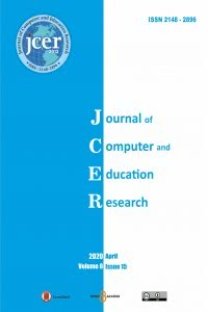Çoktan Seçmeli Maddelerde Uzmanlarca Öngörülen ve Ampirik Olarak Hesaplanan Güçlük İndekslerinin Karşılaştırılması
Madde güçlüğü, uzman kanısı, madde güçlük indeksinin kestirimi, madde analizi
A Comparison of Difficulty Indices Predicted by Experts and Calculated Empirically in Multiple Choice Items
___
- Baker, F. (2001). The basics of item response theory (2nd ed.). ERIC Clearinghouse on Assessment and Evaluation.
- Baykul, Y., & Sezer, S. (1993). Deneme yapılamayan durumlarda madde güçlük ve ayırıcılık gücü indekslerinin ve bunlara bağlı test istatiklerinin kestirilmesi [Özet]. Eğitim ve Bilim, 17(83).
- Bazvand, A. D., Kheirzadeh, S., & Ahmadi, A. (2019). On the statistical and heuristic difficulty estimates of a high stakes test in Iran. International Journal of Assessment Tools in Education, 6(3), 330–343. https://doi.org/10.21449/ijate.546709
- Cohen, R. J., & Swerdlik, M. E. (2018). Psychological testing and assessment: An introduction to tests and measurement (9th ed.). NY: McGraw-Hill Education.
- Crocker, L., & Algina, J. (1986). Introduction to classical and modern test theory. NY: Holt, Rinehart and Winston.
- Domino, G., & Domino, M. L. (2006). Psychological testing: An introduction (2nd ed.). NY: Cambridge University.
- Enright, M. K., & Bejar, I. I. (1989). An analysis of test writers' expertise: Modeling analogy item difficulty. Alınan yer https://files.eric.ed.gov/fulltext/ED395014.pdf
- Frey, B. B. (2015). 100 questions (and answers) about tests and measurement. CA: Sage.
- Haladyna, T. M., & Rodriguez, M. C. (2013). Developing and validating test items. NY: Routledge.
- Impara, J. C., & Plake, B. S. (1998). Teachers' ability to estimate item difficulty: A test of the assumptions in the Angoff standard setting method. Journal of Educational Measurement, 35(1), 69-81. https://doi.org/10.1111/j.1745-3984.1998.tb00528.x|
- Kilmen, S. (2012). Madde analizi, madde seçimi ve yorumlanması. N. Çıkrıkçı Demirtaşlı, (Ed.), Eğitimde ölçme ve değerlendirme içinde (s. 363–385). Ankara: Öz Baran Ofset.
- Lorge, I., & Diamon, L. K. (1954). The value of information to good and poor judges of item difficulty. Educational and Psychological Measurement, 14(1), 29–33. https://doi.org/10.1177/001316445401400103
- Mohan, R. (2016). Measurement, evaluation and assessment in education. PHI Learning Pvt. Özçelik, D. A. (2010). Test hazırlama kılavuzu. Ankara: PegemA.
- Quereshi, M. Y., & Fisher, T. L. (1977). Logical versus empirical estimates of item difficulty. Educational and Psychologıcal Measurement, 37(1), 91–100. https://doi.org/10.1177/001316447703700110
- Rowntree, D. (1981). Statistics without tears: A primer for non-mathematicians. Ally & Bacon.
- Salkind, N. J. (2018). Tests & measurement for people who (think they) hate tests & measurement (3rd ed.). CA: Sage.
- Taube, K. T., & Newman, L. S. (1996, 8–12 April). The accuracy and use of item difficulty calibrations estimated from judges' ratings of item difficulty [Conference presentation]. Annual Meeting of the American Educational Research Association, New York.
- Tinkelman, S. (1947). Difficulty prediction of test items. Teachers College Contributions to Education, 941, 55.
- Urbina, S. (2014). Essentials of psychological testing (2nd ed.). Wiley.
- Uyar, Ş. (2019). Madde puanları üzerinde istatistiksel işlemler. N. Doğan, (Ed.), Eğitimde ölçme ve değerlendirme içinde (s. 377–399). Ankara: Pegem Akademi.
- Whiston, S. C. (2017). Principles and applications of assessment in counseling (5th ed.). Cengage Learning.
- Yayın Aralığı: 2
- Başlangıç: 2013
- Yayıncı: Tamer KUTLUCA
A Study on Online EFL Instructors’ Teaching Satisfaction during Pandemic
Merve SERCANOĞLU ÖDEN, Yusuf İslam BOLAT, İdris GOKSU
Teachers’ Views on the Use of Mobile Phones in Schools
Sınıf Öğretmenlerinin Ekolojik Ayak İzi Farkındalık Düzeyleri
Mehmet DEMİRKOL, İbrahim ASLAN
How does Information and Communications Technology Influence Turkish Students’ Science Achievement?
Öğretmenlik Uygulaması Dersine Yönelik Beklentilerin ve Sürecin Değerlendirilmesi
Yükseköğretim Kurumlarında Eğitim Teknolojisi Üzerine Yapılmış Çalışmaların Analizi
Factors Affecting Parental Mediation Strategies in Children’s Technology Use: A Systematic Review
Rabia ÜSTÜNDAĞ ALKAN, Alper ASLAN, Yiğit Emrah TURGUT, Engin KURŞUN
